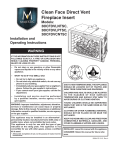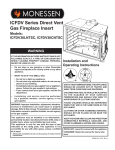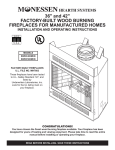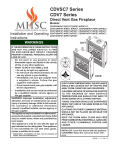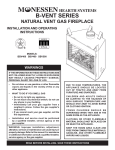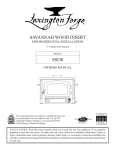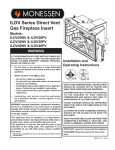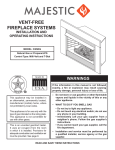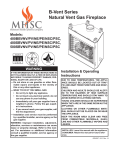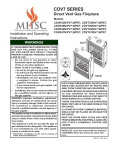Download Lexington Home Brands AI42DV User's Manual
Transcript
LEXINGTON FORGE DIRECT VENT GAS INSERT INSTALLATION AND OPERATING INSTRUCTIONS MODEL: ASHTON AI42DV WARNINGS IF THE INFORMATION IN THESE INSTRUCTIONS ARE NOT FOLLOWED EXACTLY, A FIRE OR EXPLOSION MAY RESULT CAUSING PROPERTY DAMAGE, PERSONAL INJURY OR LOSS OF LIFE. – Do not store or use gasoline or other flammable vapors and liquids in the vicinity of this or any other appliance. – WHAT TO DO IF YOU SMELL GAS • Do not try to light any appliance. • Do not touch any electrical switch; do not use any phone in your building. • Immediately call your gas supplier from a neighbor's phone. Follow the gas supplier's instructions. • If you cannot reach your gas supplier, call the fire department. – Installation and service must be performed by a qualified installer, service agency or the gas supplier. WARNING: Improper installation, adjustment, alteration, services or maintenance can cause injury or property damage. Refer to this manual. For assistance or additional information consult a qualified installer, service agency or the gas supplier. This appliance is only for use with the type of gas indicated on the rating plate. This appliance is not convertible for use with other gases, unless a certified kit is used. This appliance may be installed in an aftermarket*, permanently located, manufactured home, where not prohibited by local codes. *Aftermarket: Completion of sale, not for purpose of resale, from the manufacturer. �� � DUE TO HIGH TEMPERATURES, THE APPLIANCE SHOULD BE LOCATED OUT OF TRAFFIC AND AWAY FROM FURNITURE AND DRAPERIES. CHILDREN AND ADULTS SHOULD BE ALERTED TO THE HAZARDS OF HIGH SURFACE TEMPERATURE AND SHOULD STAY AWAY TO AVOID BURNS OR CLOTHING IGNITION. YOUNG CHILDREN SHOULD BE SUPERVISED WHEN THEY ARE IN THE SAME ROOM AS THE APPLIANCE. CLOTHING OR OTHER FLAMMABLE MATERIAL SHOULD NOT BE PLACED ON OR NEAR THE APPLIANCE. KEEP THE ROOM AREA CLEAR AND FREE FROM COMBUSTIBLE MATERIALS, GASOLINE, AND OTHER FLAMMABLE VAPORS AND LIQUIDS. READ BEFORE INSTALLING. SAVE THESE INSTRUCTIONS CONTENTS CONGRATULATIONS! You have purchased a state-of-the-art gas appliance featuring the Lex-Fire Burn System available exclusively on Lexington Forge gas appliances. The Lex-Fire Burn System sets a new standard for flame appearance through innovative log design, burner technology and ember placement. Each element effecting combustion and flame appearance was carefully scrutinized and strategically balanced during the design process to provide a product that was truly “BORN TO BURN.” Important Safety Information .......................... 3 Log Placement ................................................ 20 Product Features .............................................. 5 Surround and Trim Installation ..................... 24 Installing Facing .......................................... 24 Assembling Optional Trim ........................... 24 Installing Trim .............................................. 24 Installing On/Off Switch............................... 24 Code Approval .................................................. 5 Pre-Installation Information Installing Above 2000 Feet............................ 6 Orifice Sizes, Pressures and BTUs............... 6 Insert Dimensions ......................................... 6 Fireplace and Insert Dimensions .................... 7 General Installation Information ..................... 8 Clearances .................................................... 8 Installation......................................................... 9 Insert Clearances .......................................... 9 Mantel Clearances ........................................ 9 Hearth Requirements .................................... 9 Insert Placement ......................................... 10 Zero-Clearance (Metal) Fireplace Requirements...............................................11 Vent Installation .............................................. 12 Installation Precautions ............................... 12 Vent Requirements ..................................... 13 Altitude Considerations ............................... 13 Vent Configurations..................................... 14 Manifold Removal and Installation .............. 15 Insert Installation Check Gas Type.......................................... 16 Installing Gas Piping to Insert/Burner System Location ...................................................... 16 Checking Gas Pressure ................................. 18 Electrical Installation ..................................... 19 Electrical Wiring .......................................... 19 Remote Wall Switch .................................... 19 2 Filigree Installation......................................... 25 Door Installation ............................................. 26 Operating Instructions ................................... 27 What To Do If You Smell Gas...................... 27 Lighting Pilot for the First Time ................... 27 Lighting Pilot ............................................... 28 Lighting Burner............................................ 29 To Turn Off Gas........................................... 29 Adjusting Blower Speed .............................. 29 Cleaning Maintenance.................................... 30 Venting System ........................................... 30 Cleaning Glass............................................ 30 Pilot and Burner Flames ............................. 30 Firebox Cleaning ......................................... 30 Air Shutter Adjustment (Natural Gas Only).. 31 Glass Replacement ........................................ 32 Maintenance.................................................... 33 Maintaining Your Heater’s Appearance....... 33 Yearly Service Procedure............................ 33 Blower.............................................................. 35 Replacement Parts ......................................... 36 Troubleshooting ............................................. 38 Warranty ...........................................Back Cover 48D0139 IMPORTANT SAFETY INFORMATION WARNING INSTALLER Please leave these instructions with the owner. OWNER Please retain these instructions for future reference. • Read this owner’s manual carefully and completely before trying to assemble, operate, or service this insert. • Any change to this insert or its controls can be dangerous. • Improper installation or use of this insert can cause serious injury or death from fire, burns, explosions, electrical shock and carbon monoxide poisoning. This insert is a vented product. This insert must be properly installed by a qualified service person. The glass door must be properly seated and sealed. If this unit is not properly installed by a qualified service person with glass door properly seated and sealed, combustion leakage can occur. CARBON MONOXIDE POISONING: Early signs of carbon monoxide poisoning are similar to the flu with headaches, dizziness and/or nausea. If you have these signs, the insert may not have been installed properly. Get fresh air at once! Have the insert inspected and serviced by a qualified service person. Some people are more affected by carbon monoxide than others. These include pregnant women, people with heart or lung disease or anemia, those under the influence of alcohol, and those at high altitudes. Propane/LP gas and natural gas are both odorless. An odormaking agent is added to each of these gases. The odor helps you detect a gas leak. However, the odor added to these gases can fade. Gas may be present even though no odor exists. Make certain you read and understand all warnings. Keep this manual for reference. It is your guide to the safe and proper operation of this insert. 1. This appliance is only for use with the type of gas indicated on the rating plate. This appliance is not convertible for use with other gases unless a certified kit is used. 2. For propane/LP insert, do not place propane/LP supply tank(s) inside any structure. Locate propane/LP supply tank(s) outdoors. To prevent performance problems, do not use propane/LP fuel tank of less than 100 lbs. capacity. 3. If you smell gas • shut off gas supply. • do not try to light any appliance. • do not touch any electrical switch; do not use any phone in your building . • immediately call your gas supplier from a neighbor’s phone. Follow the gas supplier’s instructions. 4. Never install the insert • in a recreational vehicle • where curtains, furniture, clothing, or other flammable objects are less than 36" from the front, top, or sides of the insert • in high traffic areas • in windy or drafty areas 5. This insert reaches high temperatures. Keep children and adults away from hot surfaces to avoid burns or clothing ignition. Insert will remain hot for a time after shutdown. Allow surfaces to cool before touching. 6. Carefully supervise young children when they are in the room with insert. 7. Do not modify this insert under any circumstances. Any parts removed for servicing must be replaced prior to operating insert. 8. Turn insert off and let cool before servicing, installing, or repairing. Only a qualified service person should install, service, or repair the insert. Have burner system inspected annually by a qualified service person. 9. You must keep control compartments, burners, and circulating air passages clean. More frequent cleaning may be needed due to excessive lint and dust from carpeting, bedding material, pet hair, etc. Turn off the gas valve and pilot light before cleaning insert. 10. Have venting system inspected annually by a qualified service person. If needed, have venting system cleaned or repaired. See Cleaning and Maintenance, page 30. 11. Keep the area around your insert clear of combustible materials, gasoline, and other flammable vapor and liquids. Do not run insert where these are used or stored. Do not place items such as clothing or decorations on or around insert. Continued on page 4 48D0139 3 IMPORTANT SAFETY INFORMATION Continued from page 3 12. Do not use this insert to cook food or burn paper or other objects. 13. Never place anything on top of insert. 14. Do not use any solid fuels (wood, coal, paper, cardboard, etc.) in this insert. Use only the gas type indicated on rating plate. 15. This appliance, when installed, must be electrically grounded in accordance with local codes or in the absence of local codes, with the National Electrical Code, ANSI/NFPA 70, or the Canadian Electrical Code, CSA C22.1. 16. Do not obstruct the flow of combustion and ventilation air in any way. Provide adequate clearances around air openings into the combustion chamber along with adequate accessibility clearance for servicing and proper operation. 17. Do not use insert if any part has been exposed to or under water. Immediately call a qualified service person to arrange for replacement of the unit. 18. Do not operate insert if any log is broken. 19. Do not operate the insert with glass door removed, cracked, or broken. 4 48D0139 PRODUCT FEATURES AND CODE APPROVAL PRODUCT SPECIFICATIONS • This appliance has been certified for use with either natural or propane gas. See appropriate data plates. • This appliance is not for use with solid fuels. • The appliance is approved for bedroom or bedsitting room installations. • The appliance must be installed in accordance with local codes if any. If none exist use the current installation code. ANSI Z223.1/NFPA 54 in the USA, CAN/CGA B149 in Canada. • This appliance is mobile home approved. • The appliance must be properly connected to a venting system. Off/Pilot/On Knob Hi/Lo Knob Optional Remote Receiver �� � Blower Figure 1 - AI42DV Insert Gas Shutoff Valve On/Off/ Remote Switch The efficiency rating of this appliance is a product thermal efficiency rating determined under continuous operating conditions and was determined independently of any installed system. Thermal Efficiency = up to 80% CODE APPROVAL These appliances have been tested by CSA and found to comply with the established standards for VENTED GAS FIREPLACE HEATERS in the USA and Canada as follows: LISTED VENTED GAS FIREPLACE HEATER TESTED TO: ANSI Z21.88-2002/CSA 2.33-2002 STANDARDS ATTENTION MASSACHUSETTS RESIDENTS: This Lexington Forge product must be installed by a licensed gas fitter. 48D0139 5 PRE-INSTALLATION INFORMATION INSTALLING ABOVE 2000 FEET • In the USA, the appliance must be derated 4% for every 1,000 ft above 2,000 ft elevations. • In Canada, these appliances are certified for altitudes of 0 – 2000 ft, and must be de-rated by 10 percent for installations between 2000 and 4,500 ft. (derate an additional 4% for every 1,000 ft. above 4,500 ft. elevations). ORIFICE SIZES, PRESSURES AND BTUs NATURAL GAS Manifold Press: (W.C.) Maximum Supply Pressure Minimum Supply Pressure 3.5" 10.5" 4.5" PROPANE GAS Manifold Press: (W.C.) Maximum Supply Pressure Minimum Supply Pressure Model Number Max. Btu/hr Input Min. Btu/hr Input Orifice sizes (as shipped) 10" 13" 11" AI42 NATURAL PROPANE 42,000 29,000 Front: #44 Rear: #43 40,000 28,000 Front: #55 Rear: #55 The ASHTON AI42 is equipped with a variable output gas control. NOTE: Ashton AI42 model insert works without any electrical supply. Optional blower must have electricity. INSTALLATION PLANNING Plan for the installation of your insert. This includes determining the size of fireplace in which unit is to be installed, length of venting to be used, and finishing details, and whether any optional accessories (i.e. wall switch, or remote control) are desired. Consult your local building code agency to ensure compliance with local codes, including permits and inspections. 6 48D0139 FIREPLACE AND INSERT DIMENSIONS � ��� Side Front � � Fireplace Opening Top Figure 2 - External Insert Dimensions L M N - Fireplace opening height Fireplace opening width Depth of insert O P Q - Firebox width at insert depth (N) Firebox depth at insert back height (Q) Insert back height AI42 A B C 48D0139 FIREPLACE 251/4" 641mm 36" 914mm 34" 863mm D E F G H I J K FIREPLACE 237/8" 606mm 12" 304mm 323/4" 831mm 17" 432mm 191/4" 489mm 221/2" 572mm 241/4" 616mm 173/4" 451mm L M N O P Q MINIMUM OPENING 231/2" 596mm 35" 889mm 17" 432mm 1 24 /2" 616mm 17" 831mm 191/4" 489mm 7 GENERAL INSTALLATION INFORMATION The following factors should be taken into consideration: • This insert should have sufficient access for its safe operation and maintenance. • The flow of combustion and ventilation air must not be obstructed. • Minimum clearances to combustibles, such as mantels, must be maintained. See Figures 3 and 4, pages 10 and 11. • Never obstruct the front opening of the insert. • Do not install in the vicinity where gasoline or other flammable liquids may be stored. • These units can be installed in a bedroom. See National Fuel Gas Code ANSI Z233.1/NFPA 54 (current edition), the Uniform Mechanical Code (current edition), and Local Building Codes for specific installation requirements. IMPORTANT: Your direct vent insert was designed to be installed in an existing wood burning fireplace. The location and clearances are subject to local building codes. INSERT APPLICATIONS Before installing the gas fireplace insert, consider the functioning needs of the fireplace. Confirm the size of the fireplace cavity, the design of the chimney, and the availablility of the gas supply and electricity for the insert fan. IMPORTANT: Your direct vent insert is designed to be only vented vertically with a minimum height of 10 feet. When the unit is installed into a woodburning fireplace, the minimum distance the mantel can be placed above the fireplace is governed by local building codes applicable to woodburning fireplaces. Consult local authorities having jurisdiction for these clearances. The underside of the mantel will become warm. Use only finishes which are heat resistant and do not discolor. CLEARANCES WARNING MINIMUM FIREPLACE SIZE/CLEARANCES TO COMBUSTIBLES The dimensions shown in Figures 4 and 5, pages 10 and 11, are minimum clearances to maintain when installing this heater. Follow these instructions carefully to ensure safe installation. Failure to follow instructions exactly can create a fire hazard. Maintain the following minimum clearances for service and maintenance. See pages 9 and 10. 8 48D0139 INSTALLATION INSERT CLEARANCES No combustibles (ie: drapes, doors) may be within, or swing within, 36" of the front of the inset. Figure 3 - Mantel Clearances �� ������� MANTEL CLEARANCES NOTE: The combustible area above the facing must not protrude more than 3/4" from the facing. If it does, it is considered a mantel and must meet the mantel requirements shown above. HEARTH REQUIREMENTS The insert must be installed on a non-combustible hearth extending a minimum of 12" from the fireplace opening (local codes may require a larger hearth). The hearth must also extend to both sides of the face (see the table above for the exact width of the face). 48D0139 9 INSTALLATION INSERT PLACEMENT • Insert must be placed within a code-conforming masonry fireplace or a tested and listed zero-clearance (metal) fireplace. Repair any fireplace damage prior to installation. • Because the insert uses a circulation blower, clean the fireplace, smoke shelf, and chimney before installing. Paint interior surface of the fireplace with latex paint to further eliminate dust. • This heater may be placed in a bedroom. Please be aware of the large amount of heat this appliance produces when determining a location. For tight fits you may remove the manifold. See “Removing the Mainfold,” page 15 Minimum 35" (889mm) Minimum 231/2" (597mm) The insert protrudes 17" (432mm) into the fireplace. The gas line should be installed prior to insert placement. �� � Use the leveling bolts for fireplaces with recessed floors Run the on/off switch wires to the right — behind the surround panels Run the power cord either side of the insert along the face. Figure 4 - Insert Placement 10 48D0139 INSTALLATION ZERO-CLEARANCE (METAL) FIREPLACE REQUIREMENTS The damper and grate must be removed. • The smoke shelf internal baffles, screen, refractory, and metal or glass doors may be removed (if applicable). WARNING • • Do not cut any sheet metal parts of the fireplace in which this gas fireplace insert is installed. THIS IS STRICTLY PROHIBITED! Do not remove or alter the insulation or any structured rigid frame members (metal sides, floor, door frame, face of the fireplace, etc.). ����� Figure 5 - Metal Fireplace Zero-Clearance Requirements IMPORTANT:Please review the following carefully. It is normal for inserts fabricated of steel to give off some expansion and/or contraction noises during the start up or cool down cycle. Similar noises are found with your furnace heat exchanger or car engine. It is not unusual for your Lexington Forge insert to give off some odor the first time it is burned. This is due to the curing of the paint and any undetected oil from the manufacturing process. Please ensure that your room is well-ventilated. OPEN ALL WINDOWS DURING INITIAL BURN OFF/ CURING PHASE. Burn your insert for a least six (6) hours on “HIGH” the first time you use it. Place fan in the “OFF” position during this time. 48D0139 11 Read all instructions completely and thoroughly before attempting installation. Failure to do so could result in serious injury, property damage or loss of life. Operation of improperly installed and maintained venting systems could result in serious injury, property damage or loss of life. NOTICE WARNING VENT INSTALLATION Failure to follow these instructions will void the warranty. INSTALLATION PRECAUTIONS Consult local building codes before beginning the installation. The installer must make sure to select the proper vent system for installation. Before installing vent kit, the installer must read this insert manual and vent kit instructions. Only a qualified installer/service person should install venting system. The installer must follow these safety rules: • Wear gloves and safety glasses for protection. • Use extreme caution when using ladders or when on rooftops. • Be aware of electrical wiring locations in walls and ceilings. The following actions will void the warranty on your venting system: • Installation of any damaged venting component. • Unauthorized modification of the venting system. • Installation of any component part not manufactured or approved by Lexington Forge. WARNING • Installation other than permitted by these instructions. 12 This insert must be vented to the outside. The venting system must NEVER be attached to a chimney serving a separate solid fuel burning appliance. Each gas appliance must use a separate vent system. Do not use common vent systems. 48D0139 VENT INSTALLATION WARNING VENT REQUIREMENTS • Make sure the exhaust pipe on heater connects to exhaust portion of cap. Attach flex liners. See Figure 7. • Do not crimp or rupture liner when bending it into chimney offsets. • The exhaust vent must reline the entire length of chimney and terminate above chimney top. • Vent must meet all vent manufacturer’s requirements when installed. • Make sure you have the following before installing unit: • 4" and 3" UL 1777 Listed gas liner for air inlet and exhaust • Vertical termination kit (AI42TK43) Exhaust Inlet Maximum Height 40' (12.9 M) Minimum Height 10' (3 M) ALTITUDE CONSIDERATIONS WARNING This heater has been tested at altitudes ranging from sea level to 4,500 feet (USA), 0-2000 feet (Canada). In this testing, heater with standard orifice burns correctly with just an air shutter adjustment. If you need to resize orifice for use at high altitude, contact your Lexington Forge dealer. Failure to adjust air shutter properly may lead to improper combustion which can create a safety hazard. Consult your dealer or installer if you suspect an improperly adjusted air shutter Inlet Exhaust (centered on unit) Maximum 1' (305mm) Offset Figure 6 - Venting Unit 4" and 3" UL 1777 Gas Liner Termination Kit (AI42TK43) � ��������� ������� ������� � �������� � �� � Apply high-temperature silicone to lines on both ends and secure with two (2) screws. Figure 7 - Connecting Exhaust Pipe to Heater 48D0139 13 VENT INSTALLATION VENT CONFIGURATIONS Termination Kit (part # AI42TK43) Exhaust Exhaust Inlet 4" (100mm) Exhaust UL 1777 Gas Liner 3" (75mm) Inlet Recommended block-off plate (non-combustible metal). Prevents odors from chimney entering room. Suggestion: Paint fireplace cavity with latex paint to eliminate possibility of odors from fireplace circulating into the room. Any cracks or damage inside chimney must be repaired. The block-off plate (AI42AK43) must seal intake to the chimney space so that air is drawn down chimney for combustion air. Block-off Plate AI42AK43) (non-combustible materials) Inlet Masonry Fireplace Z.C. (metal) firebox Figure 8 - Inlet and Exhaust Reline Figure 9 - Exhaust Only Reline NOTE: You may use either reline configuration with a masonry or zero-clearance fireplace. 14 48D0139 VENT INSTALLATION MANIFOLD REMOVAL AND INSTALLATION The manifold is shipped attached to insert. It may be removed to allow tight installation. Manifold may be loosened and rotated for desired pipe location. Flex Vent Chimney Extra 3" (914mm) 1. Remove brick liner and baffle. Chimney 2. Remove manifold. Place manifold in fireplace. 3. Route flex vent through chimney from above. See Figure 10. Leave an extra 3" (914mm) at the top. Flex Vent 4. Attach flex vent to manifold. See Figure 11. Seal with silicone and attach with screws. Manifold Vent Termination Bracket Nut Excess Flex Vent Manifold Chimney Figure 10 - Placing Manifold Into Fireplace Figure 11 - Attaching Flex Vent to Manifold 5. Place manifold in an upright position. Have someone pull on the excess flex vent. Figure 12. Temporarily attach flex vent to top of chimney. Leave some extra slack in flex vent. Slack in Flex Vent Manifold Figure 12 - Pulling On Excess Flex Vent 48D0139 Chimney 6. Slide insert into place. Guide the manifold over the insert until it is fully in place. Figure 13. 7. Remove any slack from flex vent. Attach manifold to insert. Figure 13. 8. Remove any excess slack in flex line. Attach vent termination. Figure 13. Excess Slack Taken Out of Flex Vent 9. Replace Manifold baffle and Bracket brick liner. Nut Insert Figure 13 - Sliding Insert Into Place 15 INSERT INSTALLATION CHECK GAS TYPE Use proper gas type for the insert you are installing. If you have conflicting gas type, do not install insert. See dealer where you purchased the insert for proper insert according to your gas type. CAUTION WARNING INSTALLING GAS PIPING TO INSERT LOCATION A qualified installer or service person must connect appliance to gas supply. Follow all local codes. For propane/LP units, never connect insert directly to the propane/LP supply. This burner system requires an external regulator (not supplied). Install the external regulator between the burner system and propane/LP supply. INSTALLATION ITEMS NEEDED Before installing insert and burner system, make sure you have the items listed below. • • • • External regulator (supplied by installer) • Piping (check local codes) • Sealant (resistant to propane/LP gas) Test gauge connection* • Sediment trap (optional but recomended) Tee joint • Pipe wrench approved flexible gas line with gas connector (if allowed by local codes — not provided) * A CSA design-certified equipment shutoff valve with 1/8" NPT tap is an acceptable alternative to test gauge connection. Purchase the CSA design-certified equipment shutoff valve from your dealer. For propane/LP connections only, the installer must supply an external regulator. The external regulator will reduce incoming gas pressure. You must reduce incoming gas pressure to between 11 and 13 inches of water. If you do not reduce incoming gas pressure, burner system regulator damage could occur. Install external regulator with the vent pointing down as shown in Figure 27. Pointing the vent down protects it from freezing rain or sleet. 100 gal. (min) Propane/LP Supply Tank CAUTION External Regulator Vent Pointing Down Figure 14 - External Regulator with Vent Pointing Down (Propane/LP Only) 16 Use only new black iron or steel pipe. Internally tinned copper or copper tubing can be used per National Fuel Code, section 2.6.3, providing gas meets hydrogen sulfide limits, and where permitted by local codes. Gas piping system must be sized to provide minimum inlet pressure (listed on data plate) at the maximum flow rate (BTU/hr). Undue pressure loss will occur if the pipe is too small. When using copper or flex connectors use only fittings approved for gas connections. The gas control inlet is 3/8" NPT. 48D0139 Only persons licensed to work with gas piping may make the necessary gas connections to this appliance. CAUTION WARNING INSERT INSTALLATION A manual shutoff valve is factory installed upstream of the appliance. Union tee and plugged 1 / 8 " NPT pressure tapping point should be installed upstream of the appliance. See Figure 15. NOTE : The gas line connection may be made using 1/2" rigid tubing or an approved flex connector. Since some municipalities have additional local codes it is always best to consult your local authorities and the current edition of the National Fuel Gas Code ANSI.Z223.1, NFPA54. In Canada CAN/CGAB149 (1 or 2) Installation Code. A listed manual shutoff is factory installed upstream of appliance. Union tee and plugged 1/8" NPT pressure tapping point should be installed upstream of the appliance. See Figure 15. Check your building codes for any special requirements for locating equipment shutoff valve to inserts. Apply pipe joint sealant lightly to threads. This will prevent excess sealant from going into pipe. Excess sealant in pipe could result in clogged burner system valves. CAUTION IMPORTANT: The main gas valve is for turning on or shutting off the gas to the insert. Use pipe joint sealant that is resistant to liquid petroleum (LP) gas. We recommend that you install a sediment trap/drip leg in supply line as shown in Figure 15. Locate sediment trap/drip leg where it is within reach for cleaning. Install in piping system between fuel supply and burner system. Locate sediment trap/drip leg where trapped matter is not likely to freeze. A sediment trap traps moisture and contaminants. This keeps them from going into the burner system gas controls. If sediment trap/drip leg is not installed or is installed wrong, burner system may not run properly. Approved Flexible Gas Line Supplied with Appliance Sediment Trap/Drip Leg Tee Joint Pipe Nipple Cap Natural Gas From Gas Meter (4.5" W.C. to 10.5" W.C. Pressure) Propane/LP �� From External Regulator �� ��� (11" W.C. to 13" W.C. Pressure) � � Figure 15 - Gas Connection 48D0139 17 CHECKING GAS PRESSURE Check gas type. The gas supply must be the same as stated on the appliance’s rating decal. If the gas supply is different from the fireplace, STOP! Do not install the appliance. Contact your dealer immediately. 2. Install and attach 30" (762mm) flex line provided with on this appliance to 1/2" gas line. 3. After completing gas line connection, purge air from gas line and test all gas joints from the gas meter to the fireplace for leaks. Use a soap and water solution or a gas sniffer. 4. To adjust flame height, turn HI/LO knob to HI to get maximum pressure to burner. Turn HI/LO knob to LO to get minimum pressure. 5. 18 To check gas pressures at valve, turn captured screw counter clockwise 2 or 3 turns and then place tubing to pressure gauge over test point. Turn unit to high. See Figure 16. After taking pressure reading, be sure and turn captured screw clockwise firmly to reseal. Do not over torque. Check test points for gas leaks with a soap and water solution. Pressure Test “IN” Pressure Test “OUT” HI/LO Knob Pilot Adjustment Screw Figure 16 - Gas Pressure Check at Gas Valve WARNING 1. Do not use open flame to check for gas leaks. 48D0139 ELECTRICAL INSTALLATION ELECTRICAL WIRING CAUTION WARNING This insert will work without any electrical supply. Electricity is only needed if you install a remote wall mounted switch. Electrical connections should only be performed by a qualified, licensed electrician. Main power must be off when connecting to main electrical power supply or performing service. All wiring shall be in compliance with all local, city, and state codes. The appliance, when installed, must be electrically grounded in accordance with local codes, or in the absence of local codes, with the National Electrical Code ANSI/ NFPA 70 (latest edition) and Canadian Electrical Code, CSA C22.1. Label all wires before disconnecting when servicing controls. Wiring errors can cause improper and dangerous operation. Verify proper operation after servicing. REMOTE WALL MOUNTED SWITCH A remote wall switch and up to fifteen (15) feet of 18 Ga. wire may be used with this appliance. Attach the wall switch in a junction box at the desired location on the wall. See Figure 17. NOTE: Extended lengths of wire may cause the fireplace not to function properly. Longer length of wire is permitted if the wire is made out of larger gauge (diameter) wire. Always check with local code. BATTERY POWERED IGNITOR Figure 17 - Wiring Diagram for Wall Switch 48D0139 19 LOG PLACEMENT WARNING Before you begin — This unit is supplied with seven (7) ceramic fiber logs. Do not handle these logs with your bare hands. Always wear gloves to prevent skin irritation from ceramic fibers. After handling the logs, wash your hands gently with soap and water to remove any traces of fibers. The positioning of the logs is critical to the safe and clean operation of this heater. Sooting and other problems may result if the logs are not properly and firmly positioned in the appliance. Never add additional logs or embellishments such as pine cones or vermiculite to the heater. Only use the logs supplied with the unit. Failure to position the parts in accordance with diagrams below or to use only parts specifically approved for this heater may result in property damage or personal injury. INSTALLING LOGS AND ROCK WOOL (EMBER MATERIAL) IN FIREBOX 1. Open front door of firebox. 2. Carefully remove seven (7) logs from wrapping. 3. Place rear log (#1) against back of firebox. Line up holes in bottom of log with two (2) mounting pins in bottom of firebox. See Figure 18. 4. Line up the holes in the bottom of the left base log (#2) with pins on the left side of insert. Install left base log. See Figure 19. Rear Log (#1) Left Front Log (#2) ��� Pins ��� Pins Figure 18 - Installing Rear Log #1 20 Figure 19 - Installing Left Log #2 48D0139 LOG PLACEMENT 5. Place right base log (#3) to the right of rear log (#1). See Figure 20. 6. Place left center log (#4) on top two pins next to left base log (#2). Line up hole in bottom left center log (#4) with pin on burner. See Figure 21. Right Base Log (#3) ��� Figure 20 - Installing Right Log #3 Left Center Log (#4) ��� Pins Right Center Log (#5) Figure 21 - Installing Left Center Log #4 7. Set right center log (#5) on two pins to the left of right base log. See Figure 22. ��� Pins Figure 22 - Installing Right Center Log #5 Continued on page 22 48D0139 21 LOG PLACEMENT 8. Place one end of right top log (#6) on cutout of right base log (#3). Line up hole in bottom or right top log (#6) with pin on right center log (#5). See Figure 23. 9. Lay top “Y” log (#7) across rear log (#1) and left center logs #4. Place “Y” log (#7) on two (2) pins provided. See Figure 24. Right Top Log (#6) ��� Pin on Right Center Log (#5) Cutout on Right Base Log (#3) Figure 23 - Installing Right Top Log #6 Top “Y” Log (#7) ��� Figure 24 - Installing “Y”Log #7 22 48D0139 LOG PLACEMENT 10. Break up rock wool (ember material) into dime-sized pieces. Place evenly across burner surface and mesh of grate. See Figures 25 and 26. Do not exceed 1" depth of coverage. Lightly cover the airspace between logs and burner with small pieces rock wool for a better burner flame and glow. See Figure 26. Also, use additional small pieces of rock wool to lightly cover the airspace in front of burner. See Figure 27. Rock Wool Rock Wool ��� Figure 26 - Rock Wool Placement Figure 25 - Rock Wool Placement ��� Rock Wool Figure 27 - Installing rock Wool in Air Space Between Logs and Burner 48D0139 23 SURROUND AND TRIM INSTALLATION INSTALLING FACING 1. Line up surround with unit opening. 2. Attach surround to unit with four (4) screws provided. See Figure 28. Surround Top of Trim Trim Screws 3. Install magnetic “ L” bracket to bottom of surround with two (2) screws and (2) nuts provided. See Figure 28. Back of Trim ASSEMBLING OPTIONAL TRIM 1. Lay out trim and “L” brackets on floor. See Figure 29 “L” Bracket 2. Put trim together at 45° angles to form a corner. Insert “L” bracket into slots in back of trim. Tighten screws with flat head screwdriver. See Figure 27. Make sure there are no gaps at the 45° angle. INSTALLING TRIM 1. Slide trim over surround. See Figure 28. 2. Attach a piece of double stick tape to bottom side of surround to keep bottom from flaring out. See Figure 28. INSTALLING ON/OFF SWITCH 1. After installing surround and trim, disconnect the on/off switch from wires leading from heater. 2. Insert switch into hole in upper right side of the trim. See Figure 30. 3. Reattach wires. See Figure 30. �� � Screws Magnets Magnetic “L” Bracket Figure 28 - Installing Surround and Trim Double Stick Tape Right Trim Piece Top Trim Piece “L” Brackets Side Trim Pieces On/Off Switch (Install in trim or install in surround if trim is not used) Tape wires to back of surround with foil tape. Figure 29 - Aligning Trim on Floor 24 Figure 30 - Installing On/Off Switch 48D0139 FILIGREE INSTALLATION 1. Line up four (4) screw holes on filigree facing with four (4) screw holes on surround. See Figure 31. 2. Attach filigree facing with four (4) screws provided. See Figure 31. NOTICE INSTALLING FILIGREE FACING Remove all fingerprints from facing with a 50/50 vinegar and water solution before lighting the heater. Any fingerprints left on the facing will be permanent when heater is lit. Screws �� � Filigree Facing Screws Figure 31 - Installing Filigree Facing 48D0139 25 DOOR INSTALLATION Slide one door onto hinges. Repeat for other door. See Figure 32. NOTICE INSTALLING DOORS Remove all fingerprints from facing with a 50/50 vinegar and water solution before lighting the heater. Any fingerprints left on the facing will be permanent when heater is lit. Upper Magnetic Bracket Doors �� � Lower Magnetic Bracket Hinges Figure 32 - Installing Doors 26 48D0139 OPERATING INSTRUCTIONS WARNING FOR YOUR SAFETY READ BEFORE LIGHTING If you do not follow these instruction exactly, a fire or explosion may result causing property damage, personal injury or loss of life. A. This appliance is equipped with a pilot piezo ignition system. Follow these instructions exactly to light pilot. B. BEFORE OPERATING smell all around the appliance area for gas. Be sure to smell next to the floor because some gas is heavier than air and will settle on the floor. WHAT TO DO IF YOU SMELL GAS: • Turn off all gas to the appliance. • Open windows. • Do not attempt to light any appliance. • Do not touch any electric switch; do not use any phone in your building. • Immediately call your gas supplier from a neighbor's phone. Follow the gas supplier's instructions. • If you cannot reach your gas supplier, call the fire department. C. Use only your hand to push in, or turn the gas control knob. Never use tools. If the knob will not push in or turn by hand, don't try to repair it. Call a qualified service technician. Force or attempted repair may result in a fire or explosion. D. Do not use this appliance if any part of it has been under water. Immediately call a qualified service technician to inspect the appliance and to replace any part of the control system and any gas control that has been under water. INITIAL LIGHTING Purge air from the supply line as follows: • Open main shutoff valve. • Unscrew main pressure test point. • Leave inlet test screw open until gas comes in. • When gas is flowing, tighten inlet screw immediately. WARNING LIGHTING PILOT FOR THE FIRST TIME Never use an open flame to check for gas leak. LEAK TESTING 1. Follow the pipe from the gas supply line connection to the gas valve. Check connection for leaks with soap and water mixture. 2. Next check for gas leaks at the burner thread inlet with soap and water mixture. 3. Check the pilot for gas leaks with soap and water mixture. Continued on next page 48D0139 27 OPERATING INSTRUCTIONS T LEAK TESTING (continued) You may check for gas leaks with the following methods only: • Soap and water solution • An approved leak testing spray WARNING LIGHTING PILOT FOR THE FIRST TIME If using a soap and water solution to test for leaks, DO NOT spray solution onto control body. • Electronic sniffer Check for gas leaks in each of the following locations: • Pipe from the gas supply line connection to the gas valve • Burner thread inlet • Field made joints • Pilot • Factory made joints • Each joint or connection • All joints on valve and control body NOTE: Remove any excessive pipe compound from the connections. Excessive pipe compound can set off electronic sniffers. WARNING LIGHTING PILOT The control has an interlock device that does not allow the lighting of the insert up to the moment the safety device of the flame has not interrupted the gas flow. After that period of time (when the magnet is closed), it is possible to start the lighting operation. The gas control knob is designed to be operated by hand. DO NOT use any tools during this operation. Damaged knobs may result in serious injury. 1. Depress and turn knob counterclockwise to pilot position. If the pilot does not stay lit, repeat steps 1 and 2. ����� � �� 2. Depress fully and hold pilot gas knob. The electronic ignitor will automatically ignite the pilot. Keep knob fully depressed for a few seconds. Release and check that pilot continues to burn. �� ��� �� WARNING Figure 33 - Pilot Position 28 If the knob does not “pop” out to its original position when released, turn off gas to appliance and contact qualified service technician. 48D0139 OPERATING INSTRUCTIONS LIGHTING BURNER T MAIN BURNER SWITCH The “ON/OFF/REMOTE” switch for the main burner can be found on the right side of insert surround. This switch allows you to turn on and to turn off the main burner without using the gas valve knob. Make sure the button is in the “ON” position to light the main burner. See Figure 34. LIGHTING THE BURNER Depress and turn the knob counterclockwise than four (4) seconds for the burner to ignite. to the “ON” position. See Figure 35. It will take less PILOT POSITION Depress and turn knob to pilot position to keep burner off while maintaining the pilot light. See Figure 36. ����� �� � ��� � ��� � ��� �� Figure 34 On/Off/Remote Switch �� ��� �� ��� �� �� Figure 35 - On Position �� Figure 36 - Pilot Position TO TURN OFF GAS ��� to “OFF” ��� � � Depress and turn knob clockwise position. See Figure 37. �� ��� �� Figure 37 - Off Position ADJUSTING BLOWER SPEED The internal blower helps transfer heat from heater into room. It will not turn on until heater is up to temperature (approximately 10 minutes after starting). To turn blower off, turn knob all the way counter-clockwise . One click clockwise turns blower to high speed. Turning knob clockwise from high position decreases speed of blower. See Figure 38. Figure 38 - Blower Knob 48D0139 29 CLEANING AND MAINTENANCE Make sure the gas valve knob is in the “OFF” position. Wait at least five (5) minutes before starting maintenance. VENTING SYSTEM A qualified agency should examine the venting system annually. CAUTION CLEANING GLASS Clean the ceramic glass periodically. Condensation will sometimes form on the glass during a cold startup. This is normal for all gas fireplaces and inserts. This condensation often attracts dust and lint to the surface of the glass. The initial paint curing of the appliance can also leave a slight film on the glass. This is a temporary problem. Let glass cool before cleaning. Do not clean glass when it is hot. Damage could occur. Your should clean the glass after the first two weeks of use. After that, you should clean the glass no more than two or three times a season. Use a mild glass cleaner to clean the door. Do not use abrasive cleaners. They will damage the glass surface. PILOT AND BURNER FLAMES Visually check pilot and burner flames periodically. See Figure 39 for typical burner flame. See Figure 40 for typical pilot flame. Thermocouple Thermopile ��� Figure 39 - Typical Burner Flame Figure 40 - Typical Pilot Flame 2. Vacuum burner compartment thoroughly. 3. Vacuum any dust off logs. 4. Remove any lint from main burner and pilot. 5. Carefully replace log set, and embers in their correct positions. See pages 20 through 23 . 6. Replace door (if it has been removed). 7. Relight pilot. See page 28. 8. Turn on main burners. 30 WARNING 1. Carefully remove log set, and embers from combustion chamber. Make sure that clearances to combustibles leave enough room for maintenance and service. WARNING FIREBOX CLEANING Carefully reassemble and reseal insert properly after any cleaning or servicing. 48D0139 AIR SHUTTER ADJUSTMENT (NATURAL GAS ONLY) ADJUSTING THE AIR SHUTTER The venturi of the burner is equipped with an air shutter. The opening of the venturi has been set at 1/4" for Natural Gas and fully open for Propane installation at sea level. The rear burner on Natural Gas Models may be adjusted for high altitude as follows: • To increase air mixture, push up the adjustment rod located beneath the insert. This opens the shutter more and will stop sooting. See Figure 41. • To decrease air mixture, pull down the adjustment rod located beneath the insert. This closes the shutter. Flames will be more yellow. See Figure 42. Air Shutter Adjustment Rod Figure 41 - Push Adjustment Rod Up to Open Air Shutter Air Shutter Adjustment Rod Figure 42 - Pull Adjustment Rod Down to Close Air Shutter 48D0139 31 1. Always use gloves when handling broken glass. WARNING CAUTION GLASS REPLACEMENT Make sure the glass panel edges do not touch any metal parts during thermal expansion. Put on gloves. Remove frame from insert by releasing two clamps on bottom of insert and lifting the door up and off the unit. See Figure 43. Frame 2. Remove the 7 / 8 " rope from around glass frame. See Figure 43. 3. Using a 5/16" socket, remove hex nuts from glass retaining brackets. Remove retaining brackets. See Figure 44. 4. Carefully remove broken glass. 5. Wrap new glass pane with 3/4" gasket. Make sure you have 1/4" overlap on each side. 6. Place new glass in frame. 7. Fasten retaining brackets back into place with 5/16" nuts. 8. Replace 7/8" rope. Make sure the joint is at the bottom and there is no gap. 9. Slide door back down onto insert and fasten two clamps. See Figure 43. ��� Latches Gasket Glass Frame Figure 43 - Removing Door from Hinges Retaining Brackets Hex Nuts (not all shown) Rope Glass Figure 44 - Replacing Glass (Inside of Frame Shown) NOTE: Use only original Lexington Forge replacement parts. 32 48D0139 MAINTENANCE MAINTAINING YOUR HEATER’S APPEARANCE Fingerprints or other marks left on optional gold or nickel surface may become etched in place if they are not wiped clean prior to turning stove on. Clean gold or nickel with a 50/50 vinegar and water solution and soft cloth soft cloth. NOTE: Make sure heater is cool before cleaning. Using cleaners other than a 50/50 vinegar and water solution may leave a film that becomes permanently etched into the gold or nickel. YEARLY SERVICE PROCEDURE Thermocouple Failure to inspect and maintain heater may lead to improper combustion and a potentially dangerous situation. A qualified technician should do the following once a year. Thermopile 1. Check pilot flame. Flame should touch approximately 3/8" of the top of thermopile and touch top of thermocouple. See Figure 45. If not, contact dealer for service. 2. Turn gas control knob to “OFF” position to shut off gas to heater. See step “To Turn Off Gas”, page 29. Let heater cool for 15 minutes. Remove faceplate (see instructions included with face plate) and glass. See page 32. 3. Carefully remove log set. If logs are severely deteriorated, replace logs. Check logs for sooting. A small amount of soot along bottom of logs is normal. If Figure 45 - Before taking unit excessive sooting is found, heater must be adjusted. Contact dealer where apart, check pilot flame. Flame should touch thermocouple you bought heater. and thermopile 4. Clean burner and burner ports. Inspect the following. See Figure 46: • Check burner ports for cracks, warpage and corrosion. • Make sure burner assembly is not warped or damaged. • Check firebox and area around pilot to make sure there is no warping or damage. If any problem is found, do not use heater. Contact your dealer for service. Check walls and ceiling of firebox for deterioration Check burner ports Make sure burners are not warped or damaged ��� Figure 46 - Checking Burner Ports, Burners, Walls, and Ceiling of Unit Continued on Page 34 48D0139 33 MAINTENANCE 5. Replace log set and rock wool per instructions on pages 20-23. Replace glass. Make sure gasket along perimeter of glass contacts face of firebox and forms an airtight seal. Realign if airtight seal is not formed. Replace glass and glass frame if damaged. 6. Inspect area behind access door. Clean if necessary. Check gas control valve and all gas lines. If damaged, do not use heater. Contact your dealer. 7. Start pilot and turn on main burner. Flames should be orange/yellow and not touch top of firebox. If pilot or main burners do not burn correctly, contact your dealer for service. Monitor blower operation. 34 48D0139 BLOWER BLO24 ACCESSORY PARTS LIST: DESCRIPTION Right Blower Left Blower QTY PART NUMBER 1 1 33D0700 45D0240 1 1 1 1 45D0258K 23D6100 26D0746 41D0203 PARTS NOT SHOWN Thermostat Bracket Thermostat Speed Control Wire Harness NOTE: Unplug power cord before servicing. The blowers are attached to insert bottom and back with Velcro. To remove blower for servicing, pull away from Velcro and disconnect wires. Right Blower CAUTION Left Blower Label all wires prior to disconnection when servicing controls. Wiring errors can cause improper and dangerous operation. Verify proper operation after servicing. ����� ��� ����� 48D0139 35 REPLACEMENT PARTS �� �� �� �� �� �� �� � � � � � � �� �� � �� � �� �� �� �� �� 36 �� �� �� � �� �� 48D0139 REPLACEMENT PARTS REPLACEMENT PARTS ARE AVAILABLE THROUGH YOUR RETAILER AI42 Item Description 1 2 3 4 5 6 7 8 9 10 11 12 13 14 15 16 17 18 19 20 21 22 Burner Assembly Left Log Support Bracket Right Log Support Bracket SIT 820 Nova Valve Front Injector Rear Injector Tube Valve/Burner Pilot Assembly Rocker Switch Shutoff Valve Venturi Burner Gasket Hi/Lo Knob Extension Knob Extension ON/OFF Ignitor Battery Module Ignitor Wire Harness ON/OFF Wire Harness 3/8" Union Nipple, 10.5"x3/8" Grommet Adjuster Rod Disk Bracket QTY Natural Propane 1 1 1 1 1 1 1 each 1 1 1 2 2 1 1 1 1 1 1 1 1 1 1 48D0073 48D0025K 48D0027K 37D0117 48D0154 48D0155 48D0147K-49K 20H2048 41D0048 27D0303 45D0059 45D0032 43D0095 43D0094 45D0077 45D0078 48D0163 26D4500 48D0162 45D0241 48D0109 48D0029 48D0073 48D0025K 48D0027K 37D0118 48D0156 48D0156 48D0146K-49K 20H2049 41D0048 27D0303 45D0059 45D0032 43D0095 43D0094 45D0077 45D0078 48D0163 26D4500 48D0162 45D0241 48D0109 48D0029 1 1 1 1 1 1 1 48D0006 48D0007 48D0008 48D0151 48D0152 48D0153 48D0009 48D0006 48D0007 48D0008 48D0151 48D0152 48D0153 48D0009 1 1 1 1 1 1 48D0010 48D0011 48D0012 48D0004 48D0022K 48D0113 48D0010 48D0011 48D0012 48D0004 48D0022K 48D0113 1 1 1 1 1 33D0700 45D0240 23D6100 26D0746 26D0619 33D0700 45D0240 23D6100 26D0746 26D0619 WARNING Failure to position the parts in accordance with these diagrams or failure to use only parts specifically approved with this appliance may result in property damage or personal injury. Logs 23 24 25 26 27 28 29 Rear Log Left Log Right Log Left Center Log Right Center Log Right Top Log “Y” Log Available Not Shown Rear Brick Liner Left Brick Liner Right Brick Liner Glass Flame Deflector Vent Connector Blower Parts Blower Right Blower Left Blower Snap Disc Speed Control Blower Wire Harness 48D0139 37 WARNING WARNING TROUBLESHOOTING Turn appliance OFF and allow to cool before servicing. Only a qualified service person should service and repair the heater. Note: All troubleshooting items are listed in order of operation. OBSERVED PROBLEM POSSIBLE CAUSE REMEDY Spark ignitor will not light the pilot after repeated pressing of spark ignitor. 1. Battery needs replacing 2. Defective ignitor 1. Replace battery 2. Check connections to ignitor. Replace ignitor if ignitor connections are good, but there is no spark. 3. Check for spark arcing from the electrode to pilot. Adjust and retighten. 3. Misaligned spark electrode Pilot will not stay lit. 1. Defective thermocouple. Loose thermocouple 2. Air in gas line 3. No gas 1. Check for proper connection of thermocouple to rear of valve. 2. Bleed line. Contact dealer 3. Check shutoff valve and gas supply (LPG tank) Burner will not light when valve and burner switch are both on. 1. Defective switch 1. Check switch connections. Jump wires at switch. 2. Check connections to valve. Contact dealer. 3. Turn up thermostat to start unit. Check thermostat connections. 2. Defective thermopile 3. Thermostat set too low/defective Glass fogs up 1. Normal condition 1. Allow appliance to warm up. Glass will clear. Additives in the gas may dirty glass. Clean glass when cool. Blue flames 1. Normal during start up 1. Flames will yellow as appliance heats up. Sooting 1. Flame impingement 1. Check log position. Open shutters to increase primary air. 38 48D0139 INSTALLATION RECORDS THE FOLLOWING INFORMATION MUST BE RECORDED BY THE INSTALLER FOR WARRANTY PURPOSES AND FUTURE REFERENCE. LEXINGTON FORGE Model: _____________________________ Name of Owner: Name of Installer: Address: Address: Phone: Phone: Name of Dealer: Address: Phone: Manufactured by LEXINGTON FORGE 149 Cleveland Drive Paris, Kentucky 40361, U.S.A. 48D0139 39 WARRANTY COVERAGE Lexington Forge warrants its products to be free of defects in material and workmanship and backs each product with a Limited Lifetime Warranty. This warranty is to the original purchaser of a Lexington Forge product and is not transferable. LIFETIME WARRANTY Covered under this warranty are the insert body, combustion chamber, door frame, gold plating (manufacturing defects only), glass (thermal breakage only), heat exchange system, and burner. This coverage includes parts and reasonable labor during the first five years of ownership and parts only thereafter. FIVE YEAR WARRANTY Ceramic fiber logs, firebrick panels and secondary air tubes are covered for a period of five years from the date of purchase. TWO YEAR WARRANTY Gas valves, pilot assemblies, thermopiles, thermocouples, regulators, electrical components, cast iron grates and blowers are covered for a period of two years from the date of purchase. EXCLUSIONS Items that are not covered under this warranty include but are not limited to damage or chipping to any component surfaces, gasketing, refractory material, or trim. It does not cover installation or operational problems related to venting systems, inadequate draft, inadequate gas pressure, adjustments to the appliance, the cost of inspection, components which have been altered or modified, labor costs, removal and re-installation costs, shipping to or from the factory or authorized service center, shipping damage, damage from improper use or neglect, installation damage, damage from unauthorized service, incidental or consequential damage or negative pressure caused by mechanical systems such as furnaces, fans, clothes dryers etc. TERMS This warranty shall be void if the appliance is not installed by qualified installer in accordance with the installation instructions provided with the appliance and state and local codes. The warranty shall also be void if the appliance is not operated and maintained in accordance with the operating instructions supplied with the appliance. All service work must be performed by an authorized service representative. Any part or parts, which we deem defective, will be repaired or replaced at Lexington Forge’s option, through an authorized dealer or service provider. This warranty is expressly in lieu of other warranties, express or implied, including the warranty of merchantability of fitness for purpose and of all other obligations or liabilities. Lexington Forge does not assume for it any other obligations or liability in connection with the sale or use of the appliance. In states that do not allow limitations on how long an implied warranty lasts, or do not allow exclusion of indirect damages, those limitations of exclusions may not apply to you. You may also have additional rights not covered in this Limited Warranty. Lexington Forge reserves the right to investigate any and all claims against the Limited Warranty and decide upon the method of settlement. Lexington Forge • 149 Cleveland Drive • Paris, KY • 40361 December 2003 P/N 48D0139 • Rev. 5








































